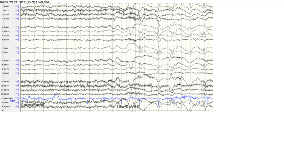Cat's Cradle: Reflexive Epilepsy in a Cri du Chat Patient During Epilepsy Monitoring Unit Admission
Abstract number :
2.103
Submission category :
4. Clinical Epilepsy / 4A. Classification and Syndromes
Year :
2018
Submission ID :
501507
Source :
www.aesnet.org
Presentation date :
12/2/2018 4:04:48 PM
Published date :
Nov 5, 2018, 18:00 PM
Authors :
Muhammad O. Salim Khan, Henry Ford Health Systems; Ryan Keating, Henry Ford Health Systems; Christopher Parres, Henry Ford Hospital; and Marianna Spanaki-Varelas, Henry Ford Health Systems
Rationale: To characterize electroencephalogram (EEG) patterns seen in Cri Du Chat syndrome Methods: We report a case of a 23 year old female with a history of Cri Du Chat (5 p deletion syndrome) admitted to the Epilepsy Monitoring Unit (EMU). Her seizures began in 2013 with staring spells with unresponsiveness, as well as drop attacks. Seizures became progressively worse despite her pre-admission anti-seizure medication regimen of clobazam, levetiracetam, and topiramate. Results: During five days of continuous video EEG monitoring, the patient had frequent episodes of staring spells, facial grimacing, and gaze deviation. As well as, flexor spasms of her head/neck during micturition and eating with unique ictal EEG patterns of simultaneous independent rhythmic alpha range activity over one hemisphere as well as 1.5-2.5 Hz polyspike and wave activity over the contralateral hemisphere. Patterns lasted for 20-30 seconds. The summative EEG findings were suggestive of a generalized epilepsy suggestive of patient’s genetic condition. Valproic acid was added to patient’s regimen to help reduce drop attacks Conclusions: Cri Du Chat is a rare genetic syndrome that is caused by deletion of the short arm of chromosome 5. Cognitive dysfunction, cat-like crying, and facial abnormalities are classically described in these patients. However, epilepsy is an extremely rare complication reported in this syndrome. Reflex seizures, triggered by specific stimuli, have been described in this patient population. Few case reports have described epilepsy in this unique patient population. In our case, we documented reflex seizures induced by micturition and eating presented with flexor spasms and and unique ictal EEGcorrelates. . Flexor spasms do not typically manifest in other reflex epilepsies as they generally present with generalized tonic clonic seizures. Other case reports seem to corroborate the presence of flexor spasms in Cri Du Chat patients with epilepsy. Funding: None

.tmb-.png?Culture=en&sfvrsn=79c1cf81_0)